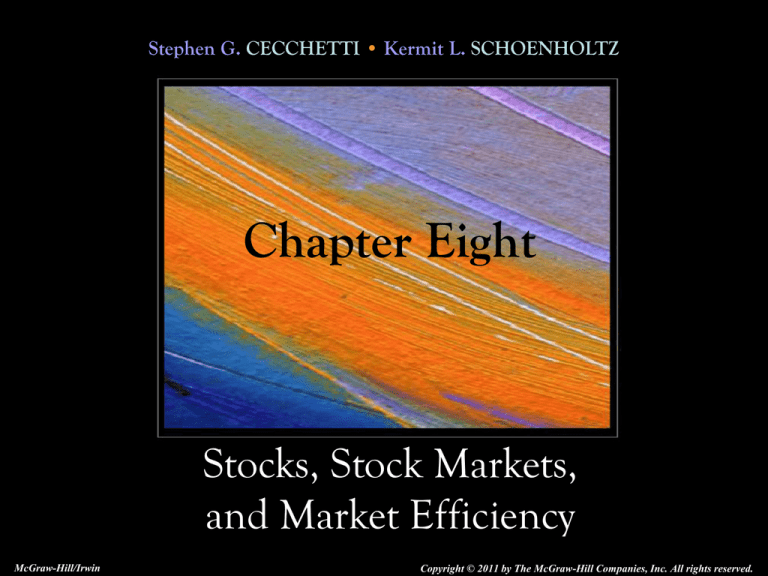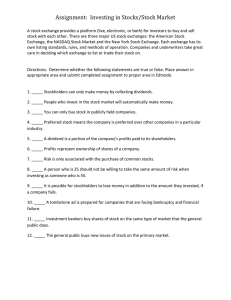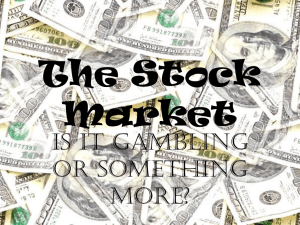
Stephen G. CECCHETTI • Kermit L. SCHOENHOLTZ
Chapter Eight
Stocks, Stock Markets,
and Market Efficiency
McGraw-Hill/Irwin
Copyright © 2011 by The McGraw-Hill Companies, Inc. All rights reserved.
Introduction
• By giving individuals a way to transfer risk,
stocks supply a type of insurance enhancing
our ability to take risk.
• Companies use stocks as a way to obtain
financing.
• Stocks are a central link between the financial
works and the real economy.
• Stocks tell us the real value of a company.
• Stocks allocate scarce resources.
8-2
Introduction
• During a week in 1929, the New York Stock
Exchange lost more than 25 percent of its
value.
• This marked the beginning of the Great Depression.
• In October 1927, prices fell nearly 30 percent
in one week.
• In the 1990’s stock prices increased nearly
fivefold, and we forgot about the black
Octobers.
8-3
Introduction
• From January 2000 to the feel after the Sept.
11, 2001 terrorist attacks, the Dow Jones
Industrial Average fell more than 30 percent.
• During the same period, the Nasdaq composite
index fell 70 percent and has remained low
ever since.
• This was dubbed the “Internet bubble”.
• The recent financial crisis lead to the stock
market roughly halving in value by early 20009
from its 2007 value.
8-4
Introduction
• The subsequent rebound from the trough has
been the sharpest since the Great Depression.
• However, despite all of this, stock prices tend
to rise steadily and slowly, collapsing only on
rare occasions when normal market
mechanisms are out of alignment.
8-5
Introduction
•
The goals of this chapter are:
•
•
•
•
To try to make sense of the stock market.
To show what fluctuations in stock value mean for
individuals and for the economy as a whole.
To look at a critical connection between the
financial system and the real economy.
Explain why we sometimes have bubbles and
crashes.
8-6
The Essential Characteristics of
Common Stock
• Stocks, also known as common stock or equity,
are shares in a firm’s ownership.
• Stocks first appeared in the 16th century as a way to
finance voyages of explorers.
• The idea was to spread the risk through joint-stock
companies, organizations that issued stock and used
the proceeds to finance several expeditions at once.
• In exchange for investing, stockholders received a
share of the company’s profits.
8-7
The Essential Characteristics of
Common Stock
• Shares were issued in small denominations,
allowing investors to buy as little or as much as
they wanted.
• Shares were transferable - an owner could sell
them to someone else.
• Although one used to receive a stock
certificate, most stockholders no longer do.
• Information is all computerized which is safer and
makes it easier to transfer.
8-8
The Essential Characteristics of
Common Stock
• The ownership of common stock conveys
rights:
• A stockholder is entitled to participate in the profits
of the enterprise.
• Stockholders are entitled to vote at the firm’s
annual meeting.
8-9
The Essential Characteristics of
Common Stock
• Although a stockholder is entitled to participate
in the profits of the firm, they are merely a
residual claimant.
• Stockholders are paid last, only after all other
creditors have been paid.
• However, stockholders have limited liability in
the firm.
• Even if a company fails completely, the maximum
amount a shareholder can lose is their initial
investment.
8-10
The Essential Characteristics of
Common Stock
• The thriving market of stocks is possible
because:
• An individual share is only a small faction of the
company’s value.
• A large number of shares are outstanding.
• Prices of individual stocks are low.
• Stockholders are residual claimants.
• Stockholders have limited liability.
• Shareholders can replace managers who are doing a
bad job.
8-11
• When you buy a house
• You consume housing services.
• You should expect to get back the original purchase
price.
• The average long-run real change in housing
prices in the U.S. is 0.20%.
• Unlike other financial investments, you don’t
get a place to live - that is your return on your
investment.
8-12
Measuring the Level of the Stock
Market
• We need to understand the dynamics of the
stock market.
• What are the connections between stock values and
economic conditions?
• We also need to be able to measure the level of
fluctuation in all stock values.
• This concept is the value of the stock market.
• We will refer to its measures as stock-market
indexes.
8-13
Measuring the Level of the Stock
Market
• Stock indexes:
• Tell us how much the value of an average stock has
changed, and
• Tell us how much total wealth has gone up or down.
• Provide benchmarks for performance of money
managers.
• You can tell whether a money manager has done
better or worse than “the market” as a whole.
8-14
The Dow Jones Industrial Average
• The DJIA
• Is the first and best known stock market index.
• Is based on the stock prices of 30 of the largest
companies in the U.S.
• Measures the value of purchasing a single share of
each of the stocks in the index.
• The percentage change in the DJIA over time is
the percentage change in the sum of the 30
prices.
8-15
The Dow Jones Industrial Average
• The DJIA is a price-weighted average, which
gives greater weight to shares with higher
prices.
• The behavior of higher priced stocks dominates
the movement of a price-weighted index.
8-16
The Standard and Poor’s 500 Index
• The S&P 500 is constructed from the prices of
many more stocks than the DJIA.
• It is based on the value of 500 largest firms in
the U.S. economy.
• It tracks the total value of owing the entirety of
those firms.
• It uses a value-weighted index where larger
firms carry more weight.
8-17
The Standard and Poor’s 500 Index
• If a firm is priced at $100 and has 10 million
shares outstanding, its total market value or
market capitalization, is worth $1 billion.
• A price weighted index gives more importance
to stocks that have high prices.
• A value weighted index gives more importance
to companies with a high market value.
• Price per se is irrelevant.
8-18
The Standard and Poor’s 500 Index
• The two types of index simply answer different
questions.
• Changes in a price-weighted index tells us the
change in the price of a typical stock.
• Changes in the value-weighted index
accurately mirror changes in the economy's
overall wealth.
8-19
• The financial pages report on the major stockmarket indexes.
• Some indexes cover a particular sector or
industry, or a set of certain sized firms.
• When you encounter a new index, make sure
you understand both how it is constructed and
what it is designed to measure.
8-20
Other U.S. Stock Market Indexes
• The Nasdaq Composite Index and the Wilshire
5000 are the next largest indexes in the U.S.
• Nasdaq is a value-weighted index of over 5000
companies traded on the over-the-counter (OTC)
market.
• Nasdaq is mainly composed of smaller, newer firms
and has recently been dominated by technology and
Internet companies.
• The Wilshire 5000 is the most broadly based index
in use; it covers all publicly traded stocks in the
U.S.
• Wilshire is value-weighted and is the best measure
of overall market wealth.
8-21
World Stock Indexes
• About a third of all the countries in the world
have a stock market and each has an index.
• Most are value-weighted indexes.
• Table 8.2 gives behavior of these in early 2010.
• The percentage change in these indexes is the most
important as their stated number does not mean
much without comparison.
• Investors view global stock markets as a means
to diversify risk away from domestic markets.
• However, there is now increased correlation of
global markets.
8-22
8-23
Valuing Stocks
• People differ on how stocks should be valued.
• Some believe they can predict changes by
looking at patterns or past movements chartists.
• Some estimate the value of stocks based on
their perceptions of investor psychology and
behavior - behavioralists.
• Others estimate stock based on both its current
assets and on estimates of future profitability the fundamentals.
8-24
Valuing Stocks
• The fundamental value of a stock is based on
the timing and uncertainty of the returns it
brings.
• We can use the information we have already
studied to compute the fundamental value of
stocks.
• Chartists and behavioralists question the
usefulness of fundamentals in understanding
the level and movement of stock prices.
8-25
Fundamental Value and the DividendDiscount Model
• A stock represents a promise to make monetary
payments on future dates, under certain
circumstances.
• The payments are usually in the form of
dividends:
• Distributions made to the owners of a company
when the company makes a profit.
• If a company is sold, the stockholders receive a
final distribution that represents their share of
the purchase price.
8-26
Valuing Stocks:
Dividend-Discount Model
• The current price is the present value of next
years price plus the dividend:
Dnext year Pnext year
Ptoday
(1 i)
(1 i)
• Expanding over an investment horizon of n
years:
Dnext year Din two years
Dn years from
Ptoday
.....
2
(1 i)
(1 i)
(1 i) n
now
Pn
years from now
n
(1 i)
8-27
Valuing Stocks:
Dividend-Discount Model
• The price today is the present value of the sum
of the dividends plus the present value of the
price at the time the stock is sold n years from
now.
• What if a company does not pay dividends?
• We estimate when the company will start paying
dividends and use the present-value framework.
• We must know something more about annual
dividend payments.
8-28
Valuing Stocks:
Dividend-Discount Model
• Assume that dividends grow at a constant rate
of g per year so:
Dnext year Dtoday(1 g)
.
• As long as growth remains constant, we can do
this
for n year from now:
Dn
years from now
Dtoday(1 g)
n
8-29
Valuing Stocks:
Dividend-Discount Model
• We can rewrite the price equation as:
Dtoday(1 g) Dtoday(1 g) 2
Dtoday(1 g) n Pn years from
Ptoday
...
2
n
(1 i)
(1 i)
(1 i)
(1 i) n
.
now
• But we don’t know the price in n years, so we
assume firm pays dividends forever turning the
stock into something like a consol.
• We can then covert the above into:
Ptoday
Dtoday(1 g)
ig
8-30
Valuing Stocks:
Dividend-Discount Model
• This relationship is the dividend-discount
model.
• The model tells us that stock prices should be
high when
• dividends are high (Dtoday),
• dividend growth is rapid (g is large), or
• the interest rate (i) is low.
• Although this model is simple, we have
ignored risk in deriving it.
8-31
Why Stocks are Risky
• When you buy stocks, it is as if you put up
your wealth to buy the firm and borrow the
rest.
• Stockholders get part of the profits, but only after
everyone else is paid, including bondholders.
• The borrowing creates leverage, and leverage
creates risk.
• The more debt, the more leverage and the
greater the owners’ risk.
8-32
Why Stocks are Risky
• Imagine a firm that only needs a $1000
computer.
• Once installed, the firm will have equal
probability of earnings:
• $80 in bad times.
• $160 in good times.
• Financing can be part equity (stock) & part
debt (bonds).
• Debt can be obtained at a 10% interest rate.
8-33
Return to Debt & Equity Holders for
Different Financing Assumptions
8-34
Why Stocks are Risky
• Stocks are risky because shareholders are
residual claimants.
• They never know for sure how much their return
will be.
• In contrast, bond holders receive fixed nominal
payments and are paid before stockholders in
the event of bankruptcy.
8-35
• Sometimes investment reports imply that you
can evaluate a fund’s performance simply by
adding the percentage loss and gain over a
period to get a total percent change.
• This is not the case.
• If a firm has a loss of 75%, an increase of 300% is
required to return to initial level.
• In general, the percentage required to return to
original value = 100 d
, where d is initial
(100 d)
decline.
8-36
Risk and the Value of Stocks
• Stockholders require compensation for risk.
• The higher the risk, the higher the compensation.
• An investor will buy a stock with the idea of
obtaining a certain return, which includes
compensation for the stock’s risk.
• We know the return to holding stock for one
year
Dnext year Pnext year Ptoday
Ptoday
Ptoday
8-37
Risk and the Value of Stocks
• We can think of the required return as the sum
of the risk-free return and the risk premium
(equity risk premium).
• We can write this as:
Required Stock Return (i)
= Risk-free Return (rf) + Risk Premium (rp)
• Rewrite dividend-discount model:
Ptoday
Dtoday(1 g)
rf rp g
8-38
Risk and the Value of Stocks
• We can summarize as follows from this
equation:
8-39
The Theory of Efficient Markets
• The basis for the theory of efficient markets is
the notion that the prices of all financial
instruments reflect all available information.
• Markets adjust immediately and continuously to
changes in fundamental values.
• This implies that stock price movements are
unpredictable.
• Any prediction that causes people to buy or sell the
stock, thereby changes the price through simple
supply and demand.
8-40
The Theory of Efficient Markets
• This means active portfolio management will
not yield a higher return than of the broad
stock-market index, year after year.
• Evidence suggests both that:
• Prices are unpredictable, and
• Professional money managers cannot beat an index
like the S&P 500 regularly. Their returns are 2%
lower on average.
8-41
The Theory of Efficient Markets
• But we do see managers who claim to exceed
the market. How?
• They have inside information, which is illegal.
• They are taking on risk and are compensated as
such.
• They are lucky.
• Markets aren’t efficient.
• This means that high or low investment returns
could simply be a result of chance.
8-42
The Theory of Efficient Markets
• Suppose 225 million people start with a dollar
and pair off to flip a coin once. The winner
takes the $2 and moves on to next round.
• Do this over and over again.
• After 20 flips, there will be 215 people left with
over $1 million each.
• Did the winners know anything special?
• As is true in the stock market, the number of
people who “win” is about the same number as
we would expect to be lucky.
8-43
• There 2 stock exchanges in China.
• Shanghai (east coast)
• Shenzhen (near Hong Kong)
• Each firm issues 2 types of shares.
• A-shares (only Chinese investors until 2001)
• B-shares (only foreigners)
• Prices on A-shares were 4 times prices on B-shares.
• But they are the same stock - why so different?
• Problem was that there was a shortage of A-shares
created by the government.
• Shortage drove up price and when released, prices fell
more than 50 percent from their peak.
8-44
Investing in Stocks For the Long Run
• Stocks appear to be risky, but people hold a
substantial proportion of their portfolio in
stock.
• Either stocks are not that risky or people are
not that risk averse.
• What is the case?
8-45
Investing in Stocks For the Long Run
• Figure 8.2 plots the one-year real return of the
S&P 500 for 140 years.
• The average real return was 8% per year.
• In the past 50 years:
• The minimum return was -34% (in 2008).
• The maximum return was +31% (in 1996).
• Professor Jeremy Siegel suggested that
investing in stocks is risky only if you hold
them for a short time.
8-46
Investing in Stocks For the Long Run
• If you hold stocks long enough, they are not
that risky.
• If we look at holding stocks for 25 years
instead of one year.
• The minimum average annual real return was 2.5%.
• The maximum average annual real return was
11.3%.
• Between 1871 and 1992 there were no 30-year
periods where bonds outperformed stocks.
• When held long enough, stocks are less risky than
bonds.
8-47
Investing in Stocks For the Long Run
8-48
• Prepackaged mutual funds are a great way to
buy stocks.
• Mutual funds offer
•
•
•
•
•
Affordability: small initial investment
Liquidity: can withdraw quickly
Diversification: portfolio of stocks
Management: professionals
Cost: look for low management fees
8-49
• Markets may use available information
efficiently and still face large setbacks if the
information is incomplete or incorrect.
• An important source of the financial crisis of
2007-2009 was the failure to understand and
manage risks in the U.S. housing market.
• The efficient market hypothesis does not rule
out large swings in market prices when new
information becomes widely available.
8-50
The Stock Market’s Role in the
Economy
• The prices determined in the stock market tell
us the market value of companies.
• This guides the allocation of resources.
• If stock prices accurately reflect fundamental
values, the resource allocation mechanism
works well.
• However, stock prices sometimes deviate
significantly from the fundamentals.
8-51
The Stock Market’s Role in the
Economy
• Both euphoria and depression are contagious
• When investors become unjustifiably exuberant,
prices rise regardless of the fundamentals.
• This creates bubbles, persistent and expanding gaps
between actual stock prices and those warranted by
the fundamentals.
• Bubbles lead to crashes.
• This explains the very jagged pattern in annual
stock returns.
8-52
The Stock Market’s Role in the
Economy
• Bubbles affect everyone because they distort
economic decisions that companies and
consumers make.
•
•
•
•
Companies sell shares for prices that are too high.
Companies then invest too much.
Those not in the euphoria invest too little.
People think they are wealthier than they are and
spend too much.
8-53
The Stock Market’s Role in the
Economy
• Crashes do the opposite.
• The shift from over-optimism to excessive
pessimism causes a collapse in investment and
economic growth.
• Large stock market swings alter economic
prospects even if grounded in fundamentals.
• The recent financial crisis, the incentive to pull
back on investment intensified helping to
amplify the recessions of 2007-2009.
8-54
• The Nasdaq is composed of numerous small
start-ups and large information technology
firms.
• It doubled in value from September 1999 to March
2000 and then it fell by 70% over the next year.
• This did change how companies could gain
financing - directly from capital markets
instead of relying on venture capitalists.
• Downside were large losses to investors and
warped investors’ decisions.
8-55
Stephen G. CECCHETTI • Kermit L. SCHOENHOLTZ
End of
Chapter Eight
Stocks, Stock Markets,
and Market Efficiency
McGraw-Hill/Irwin
Copyright © 2011 by The McGraw-Hill Companies, Inc. All rights reserved.




